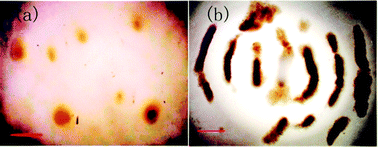Ultrafast particle assembly plays an important role in subsequent analytical procedures and the development of miniaturized biological and chemical sensors. In this paper, standing surface acoustic wave (SSAW) devices are employed to drive nanoparticles in microlitre droplets with different concentrations of sodium chloride by exciting a MHz-order acoustic wave. Different patterns formed by particles are strongly dependent on the concentrations of sodium chloride. Two forces, i.e., the dielectrophoresis (DEP) force generated by the alternating voltage, and the fluid viscous drag force generated by the acoustic streaming, should dominate the particles' assembling process, and induce various assembling patterns. The intricate and interesting interplay between the fluid viscous drag force and the dielectrophoresis (DEP) force on the particles is investigated in this study. We consider electric dipolar interaction to study behaviors of particles in droplets with different sodium chloride concentrations caused by SSAWs. Theoretical analysis and experiments reveal that nanoparticles would form a regular pattern only when the dielectrophoresis (DEP) decreased via increasing the conductivity of the droplet.

